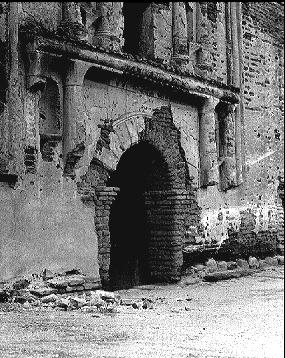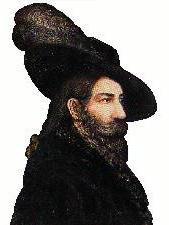|
Kino Missions:
San José de Tumacácori
 Tumacácori
is derived from two Pima words, chu-uma and kakul, probably having
reference to a flat, rocky place.
Father Kino
established it as a mission in January 1691, one day before
Guevavi,
making it the oldest mission site in Arizona. For many years, though,
it was a visita or visiting station of the mission headquarters at
Guevavi. During most of those years, it was located on the east side
of the Santa Cruz River, and services were held in a small adobe
structure built by the
Pima
inhabitants of the village. It was originally called San Cayetano de
Tumacácori. After the Pima rebellion of 1751, the mission was moved to
the present site on the west side of the river and renamed San José de
Tumacácori. Here the
first
actual church edifice was built. Tumacácori
is derived from two Pima words, chu-uma and kakul, probably having
reference to a flat, rocky place.
Father Kino
established it as a mission in January 1691, one day before
Guevavi,
making it the oldest mission site in Arizona. For many years, though,
it was a visita or visiting station of the mission headquarters at
Guevavi. During most of those years, it was located on the east side
of the Santa Cruz River, and services were held in a small adobe
structure built by the
Pima
inhabitants of the village. It was originally called San Cayetano de
Tumacácori. After the Pima rebellion of 1751, the mission was moved to
the present site on the west side of the river and renamed San José de
Tumacácori. Here the
first
actual church edifice was built.
Father Antonio de los Reyes
on 6 July 1772 submitted a report on the condition of the missions in
the Upper and Lower Pimeria Alta. This was his report on San José de
Tumacácori as translated by Father Kieran McCarty.
The village of San Jose
at Tumacácori lies seven leagues to the south of Guevavi and one
from the Presidio of Tubac, in open territory with good lands. In
this village they have a church and house for the Missionary devoid
of all ornament and furnishing. According to the Census Book, which
I have here before me, there are twenty-two married couples, twelve
widowers, ten orphans, the number of should in all ninety-three.
 In
1775 the
Anza Expedition passed through Tumacácori on its way to the Tubac
Presidio. What the mission supplied the Anza Expedition in tangible
goods in unknown. However, it is known that it provided room and
board for priests associated with the group for eight days between
October 15 and 23, 1775 while last minute preparation were being made
at the
Tubac Presidio staging base for the final push into the
wilderness. In
1775 the
Anza Expedition passed through Tumacácori on its way to the Tubac
Presidio. What the mission supplied the Anza Expedition in tangible
goods in unknown. However, it is known that it provided room and
board for priests associated with the group for eight days between
October 15 and 23, 1775 while last minute preparation were being made
at the
Tubac Presidio staging base for the final push into the
wilderness.
Padre Pedro
Antonio de Arriquibar, the resident missionary at Tumacácori,
hosted the group of four other priests. Father Pedro Font, missionary
from San José de los Pimas south of present-day Hermosillo was
assigned as chaplain for the group and would accompany
Anza all the
way to San Francisco and back to Horcasitas. Father Garcés of
Bac near Tucson
and Eixarch
of Tumacácori were assigned to go to the Yuma settlements on the
Colorado River to begin preparations for the establishment of missions
there. And finally, Padre Felix Gamarra was assigned to take Garcés
place at Bac.
One or more of these priests
walked to Tubac each day to celebrate Mass for the members of the
traveling colony. And, all five were there for Mass held on the
morning of October 23rd when the expedition departed.
 The
Franciscans began work in 1800 on an ambitious undertaking - a
church that would match the frontier baroque glory of the
celebrated Mission
San Xavier del Bac not far to the north. Under the direction of a
master mason, a maestro de albanil, a crew of Indian and
Spanish laborers laid five-foot thick cobblestone foundations that
year, but construction ground to a halt as funds dried up. Over the
next few years they were able to add a few courses of adobe bricks,
bringing the walls up to seven feet. These were plastered inside and
out and decorative handfuls of crushed brick were pressed into the wet
plaster. The
Franciscans began work in 1800 on an ambitious undertaking - a
church that would match the frontier baroque glory of the
celebrated Mission
San Xavier del Bac not far to the north. Under the direction of a
master mason, a maestro de albanil, a crew of Indian and
Spanish laborers laid five-foot thick cobblestone foundations that
year, but construction ground to a halt as funds dried up. Over the
next few years they were able to add a few courses of adobe bricks,
bringing the walls up to seven feet. These were plastered inside and
out and decorative handfuls of crushed brick were pressed into the wet
plaster.
It was not until 1821 that
work truly resumed. An enterprising Franciscan,
Father Juan
Bautista Estelric, sold 4,000 head of the mission's cattle to a
local rancher, Don Ignacio Perez, and with the first payment hired a
new master and pushed the work ahead. The walls were raised to 14
feet, but the rancher stalled on his payments and construction again
ceased. Two years later,
Father Ramon
Liberós, a persistent friar, finally got the rancher to pay his
bill, and work resumed. Within a few years the church was almost
completed, although the bell tower was never capped with its dome.
The church must have been a striking landmark in the flat Santa Cruz
Valley, with its embellished and painted facade and plaster walls
embedded with crushed red brick.
Home |
Planning Your
Visit |
Park Tour |
Special
Events |
Anza Trail |
Priests |
Father Kino
| Kino
Missions |
Natives |
Natural Resources |
Educational Resources |
Preservation
Efforts |
Volunteering
| Mission 2000
| Site Map
|